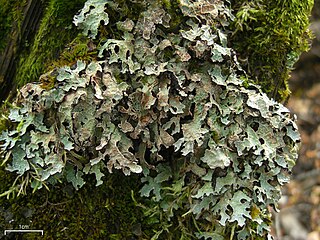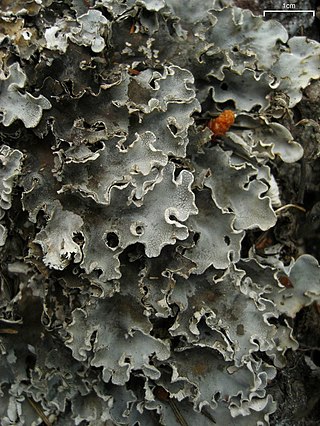
Peltigera is a genus of approximately 100 species of foliose lichens in the family Peltigeraceae. Commonly known as the dog or pelt lichens, species of Peltigera are often terricolous, but can also occur on moss, trees, rocks, and many other substrates in many parts of the world.
Gypsoplacaceae is a family of lichenized fungi in the order Lecanorales. This is a monotypic family, containing the single genus Gypsoplaca, which has a widespread distribution. The family and genus were described as new in 1990 by Norwegian lichenologist Einar Timdal. Gypsoplaca originally contained only the type species, Gypsoplaca macrophylla, but four species were added to the genus in 2018.

Rhizocarpon is a genus of crustose, saxicolous, lecideoid lichens in the family Rhizocarpaceae. The genus is common in arctic-alpine environments, but also occurs throughout temperate, subtropical, and even tropical regions. They are commonly known as map lichens because of the prothallus forming border-like bands between colonies in some species, like the common map lichen.
Peltigera vainioi is a species of lichen in the family Peltigeraceae. It is found in high-elevation locations in South America. It is a somewhat unusual species in its genus, characterized by a single holdfast that attaches to its substrate, and pores in its cortex.

Peltigera degenii is a species of foliose lichen in the family Peltigeraceae. It was first formally described in 1927 by Hungarian lichenologist Vilmos Kőfaragó-Gyelnik. The Chinese species Peltigera neodegenii is similar in appearance. Peltigera degenii has a shiny upper surface. In North America, it is a relatively rare forest species.
Orvo Vitikainen is a Finnish lichenologist. He entered the University of Helsinki in 1961, from where he obtained a Candidate of Philosophy degree in 1966, and a Licentiate of Philosophy in 1971. He later earned a Ph.D. from this institution in 1994, under the supervision of Teuvo Ahti. Between the years 1961 and 1981 he was a junior curator of cryptogams at the University of Helsinki Botanical Garden, and then from 1983 to 2004 he was the head of the lichen herbarium. Here he managed the internationally valuable collections of the early lichenologists Erik Acharius and William Nylander. He has collected thousands of specimens for the herbarium from various locations in Finland, but also internationally, including Sweden, Norway, Denmark, Russian Karelia, Scotland, Austria, Italy, Hungary, Croatia, Montenegro, Tanzania, Kenya, British Columbia, and Brazil. In 1992–1994, he was a scientist of the Finnish Academy in the Ahti research group.
Punctelia ulophylla is a species of foliose lichen in the family Parmeliaceae. It is found in Europe, where it grows on the bark of a variety of trees.

Umbilicaria hyperborea, commonly known as blistered rock tripe, is a species of foliose lichen in the family Umbilicariaceae. It is widely distributed in arctic and alpine regions.

Parmelia ernstiae is a species of foliose lichen in the family Parmeliaceae. It occurs in Europe.
Toensbergia is a genus of lichen-forming fungi in the family Sporastatiaceae. The genus was circumscribed by Mika Bendiksby and Einar Timdal in 2013. The genus name honours Norwegian lichenologist Tor Tønsberg, "in appreciation of his important work on sorediate, corticolous lichens". The type species is Toensbergia leucococca, which was formerly classified in genus Hypocenomyce, presumably due to its resemblance to Hypocenomyce xanthococca.

Parmelia barrenoae is a species of foliose lichen in the large family Parmeliaceae. It was formally described as a new species in 2005. Before this, it was lumped together as one of several lichens in the Parmelia sulcata group—a species complex of genetically distinct lookalikes. Parmelia barrenoae is widely distributed, occurring in Europe, western North America, Africa, and Asia.
Peltigera papuana is a lichenized fungus in the family Peltigeraceae. It was described in 2009 from Madang Province of Papua New Guinea, from which it obtained its specific epithet. Genetic analysis of both the mycobiont and the photobiont, which is a Nostoc cyanobacterium, suggests that the evolutionary origin of Pelitgera papuana is from an ancient dispersal event from South America, although this remains inconclusive.

Peltigera rufescens, commonly known as the field dog lichen, is a species of terricolous (ground-dwelling), foliose lichen in the family Peltigeraceae. The common and widespread species has a cosmopolitan distribution.
Peltigera shennongjiana is a species of terricolous (ground-dwelling), foliose lichen in the family Peltigeraceae. Found in Central China, it was formally described as a new species in 2016 by Liu-Fu Han and Shou-Yu Guo. The type specimen was collected from Laojunshan Mountain in the Shennongjia Forestry District at an altitude of 900 m (3,000 ft); here it was found growing on mosses over rocks and soil. The species epithet refers to the type locality.
Biatora oxneri is a species of corticolous (bark-dwelling) lichen in the family Ramalinaceae. It is found in the Russian Far East and in South Korea.
Peltigera fimbriata is a species of foliose lichen in the family Peltigeraceae. Found in Papua New Guinea, it was formally described as a new species in 2009 by lichenologists Orvo Vitikainen, Emmanuël Sérusiaux, Bernard Goffinet, and Jolanta Miądlikowska. The type specimen was collected between Mt. Sarawaket Southern Range and Iloko village The species epithet fimbriata refers to the characteristic long hairs that occur on the upper thallus surface.
Peltigera weberi is a rare species of foliose lichen in the family Peltigeraceae. It is found in Papua New Guinea, where it grows on road banks and on earth and rock debris.
Coccocarpia melloniorum is a rare species of foliicolous (leaf-dwelling) lichen in the family Coccocarpiaceae. Found in the Philippines, the lichen is characterised by its microfoliose thallus and squamiform (scale-shaped) isidia.

Verseghya thysanophora, commonly known as the mapledust lichen, is a species of mostly corticolous (bark-dwelling), leprose lichen in the family Pertusariaceae. This common species is widely distributed in the Northern Hemisphere. The thallus of the lichen is a thin patchy layer of granular soredia, pale green to yellowish green in colour. The main characteristics of the lichen include the presence of lichen products known as thysanophora unknowns, and the conspicuous white, fibrous prothallus that encircles the thallus.

Thalloidima is a genus of lichen-forming fungi in the family Ramalinaceae. It has 13 species.








